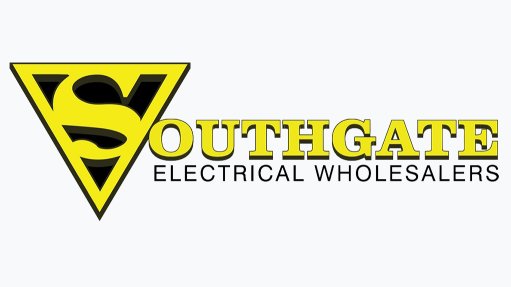Pace of platinum-enabled green hydrogen adoption building up steadily worldwide

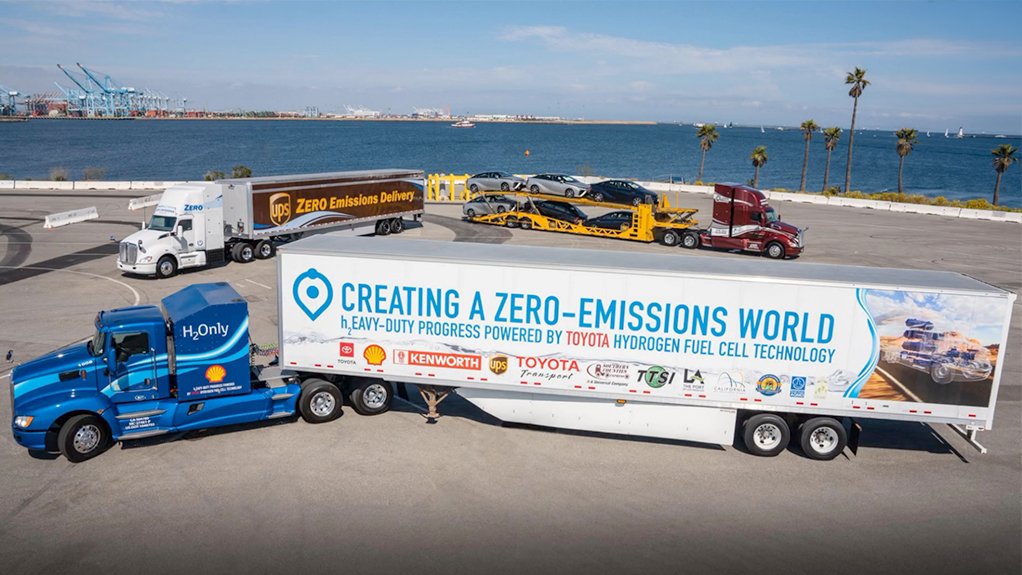
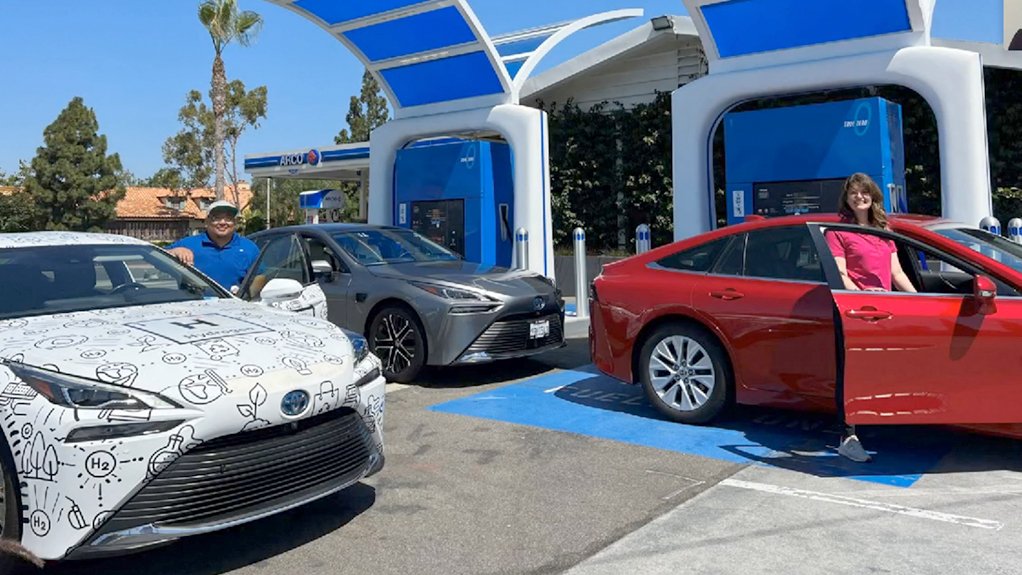
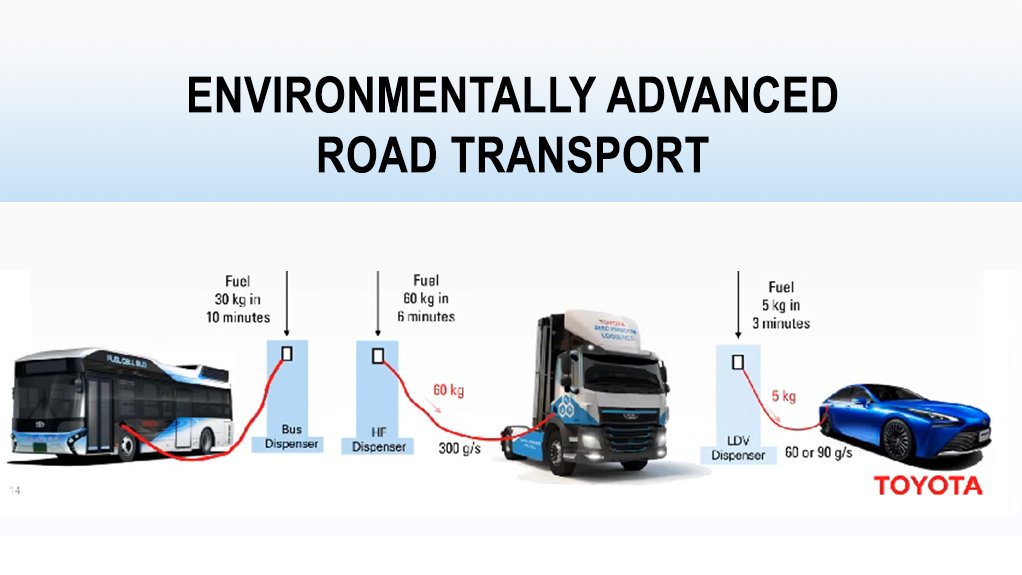
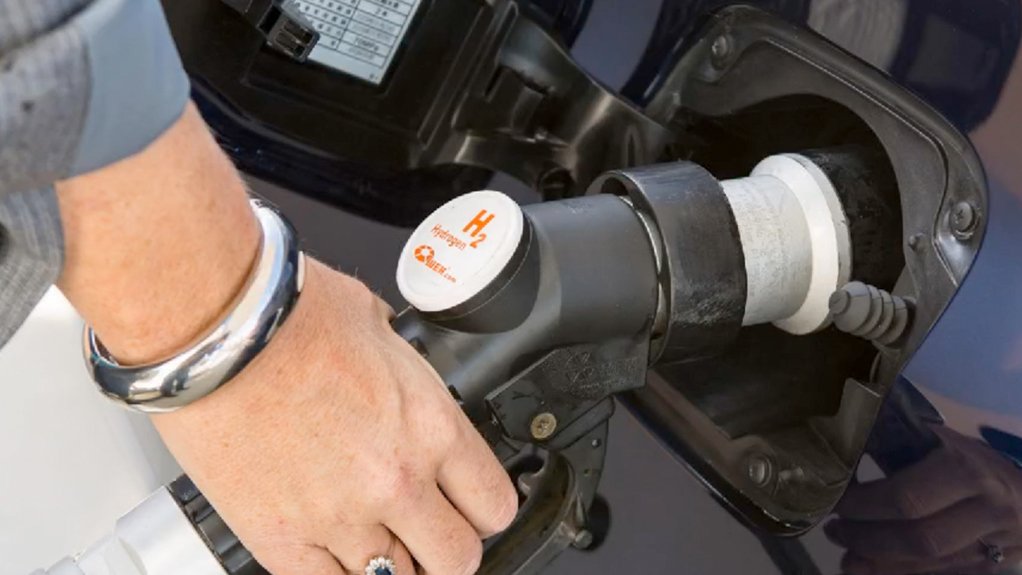
Platinum-enabled hydrogen fuel cell electric heavy duty vehicles active at Los Angeles port.
Hydrogen refuelling quickening for all sizes of hydrogen fuel cell electric vehicles.
Hydrogen refuelling quickening.
Hydrogen refuelling.
JOHANNESBURG (miningweekly.com) – The pace of platinum group metals- (PGM-) enabled green hydrogen generation and clean PGM-catalysed fuel cell electricity adoption is building up steadily worldwide.
In a global online communication conducted by Mission Hydrogen and covered by Mining Weekly, Japan’s Toyota this week strongly re-emphasised the forward momentum of big and small hydrogen fuel cell electric mobility.
Simultaneously, in Europe, a global pioneer in the production of green and renewable hydrogen, Lhyfe, announced the building and operating of a green hydrogen production plant for Deutsche Bahn in Tübingen, while Siemens Mobility is collaborating with Tyczka Hydrogen and Smart Train Lease in the hydrogen railway sector to provide hydrogen fuel cell trains.
Canada has passed a major clean hydrogen investment tax credit, which will provide green hydrogen developers with tax rebates as big as 40% off their project costs when they develop within the country. Others making similar moves have included Australia, Japan, Saudi Arabia, India and the US.
Air Products has announced that it intends building a network of permanent, commercial-scale, multimodal hydrogen refuelling stations stretching from northern to southern California, with the New York Stock Exchange-listed company describing the building of robust hydrogen infrastructure as critical to meeting global climate change goals.
As the world's largest supplier of hydrogen, Air Products has hands-on operating experience with more than 250 hydrogen fuelling station projects in 20 countries; its technologies are used in more than 1.5-million fuelling operations a year.
In South Korea, Hyundai's XCIENT fuel cell electric heavy-duty hydrogen truck has clocked 10-million kilometres of total driving distance in Switzerland in three years and eight months, which is seen as testament to the technology's long-term reliability.
In Germany, Hamburg is positioning itself as an international hub in the European hydrogen network, covering both regional and parts of national and European hydrogen supply.
Norway is funding a new hydrogen cargo ship conversion project that will refit green hydrogen fuel cells into an existing vessel to make it environment friendly.
Steps are being taken to locate a green hydrogen-cleaned stainless steel production facility in Savoie, France, that will also provide green hydrogen to decarbonise mobility in the French Alps region where the 2030 Winter Olympics are to be held. In the process, green hydrogen will be highlighted as the sustainable model of winter tourism.
By deciding to use green hydrogen at its Ugitech plant in Ugine, in the French Alps, Swiss Steel Group evoked this comment from Lhyfe vice-CEO Philippe Desorme: “Green hydrogen can and must be deployed as quickly as possible.”
At the Tübingen innovation hub, DB Energie is testing new technologies for sustainable rail energy supply, including in the H2goesRail project. Using the green hydrogen produced, a climate-neutral hydrogen train will be put into operation this year on a test route in Baden-Württemberg, between Tübingen, Horb and Pforzheim.
"This project demonstrates the economic viability of hydrogen solutions in the transport and mobility sector," Lhyfe central and eastern Europe head Luc Graré commented.
Speaking to Australian media at a preview event for its iX5 hydrogen prototype car, the head of BMW’s hydrogen programme Jurgen Guldner, who recently also took part in a clean mobility presentation in South Africa, reaffirmed BMW's strong faith in hydrogen fuel cell electric vehicle (FCEV) technology. A fleet of BMW iX5 hydrogen cars is already on South Africa's roads, with refuelling taking place in Midrand.
Anglo American Platinum CEO Craig Miller emphasised at Resources for Africa’s 2024 London Indaba that platinum-enabled and hydrogen-powered FCEVs are poised to play a key role in zero-emission global transport. “We continue to build new partnerships in the broader ecosystem. This includes our collaboration with BMW Group and Sasol to test the iX5 SUV prototype on South African roads, as well as supporting the deployment of retrofitted Stellantis people-carriers, together with Toyota Motor Corporation Mirai and Hyundai Motor Company Nexo, in Paris and Brussels-based taxi fleets,” said Miller.
The Toyota Hilux FCEV pickup is moving on to its last phase of the joint development prototype project, having completed nine others.
The Fuel Cell & Hydrogen Energy Association and the Japan Hydrogen Association have affirmed strong commitment to continued collaboration advocating for hydrogen and fuel cell industries in Japan and America.
All this is happening with PGMs, overwhelmingly hosted by South Africa, which are at the forefront of technology innovation owing to their durability, malleability and conductivity going hand-in-glove with the global green energy transition.
As a renewable-energy source, hydrogen could help to drive decarbonisation in the rail industry by enabling a switch from fossil diesel. Hydrogen power would be particularly valuable on routes where electrification is difficult.
Interestingly, many of PGM-enabled proton exchange membrane and PGM-enabled FCEV advances are likely to be highlighted from July 8 to July 11 next week at the Shanghai Platinum Week, where South Africa will be very well represented.
HYDROGEN SONGS
Even hydrogen songs are being composed, as one could hear on Wednesday, when Jackie Birdsall, senior engineering manager of the fuel cell integration group of Toyota North America, and Vincent Mittelaer, senior engineer for hydrogen station compliance of Toyota Motor Europe, shared decades of experience to a global online audience, which heard that the first country to adopt a national hydrogen strategy was Japan, where Toyota has envisioned decarbonised mobility for decades.
Toyota FCEVs on the market include the Mirai passenger car, the Hilux pickup prototype and several heavy-duty trucks, including vehicles being developed in collaboration with Kenworth, Isuzu and Daimler.
Intent on attaining full carbon neutrality by 2040, Europe requires all new vehicles to be zero-emission as of 2025, Mittelaer highlighted.
By 2030, all manufacturing plants and facilities must also be carbon neutral and recycling must be well under way.
Importantly, hydrogen trucks, trains, ships and buses in use share the same components and parts by way of a fuel cell module.
“By sharing these components, we can greatly reduce the price, when we produce in very high numbers,” Mittelaer pointed out.
“We are going to reuse these parts and in that way fuel cells can become cheaper when used in commercial vehicles.”
Light-duty and heavy-duty vehicles are contributing to the development of refuelling infrastructure, of which there should be about 428 and a minimum capacity of 1 000 kg of hydrogen a day.
More than 70% of the refuelling stations, which must be built by 2030, are in urban nodes and must be able to serve light-duty and heavy-duty vehicles.
Europe, the US and Japan have the same target of providing 60 kg of hydrogen to vehicles in less than 10 minutes.
“We need to hurry up and build the refuelling stations very quickly, using proven technology,” Mittelaer commented.
Heavy-duty FCEVs are playing a role at a port in Los Angeles and Mirai’s are taking five minutes to refuel in California, Birdsall communicated and narrated how a quiet and clean hydrogen fuel cell generator is being used to recharge battery electric vehicles.
“This is becoming more of a need around North America where for any reason battery electric vehicles can’t get access to the grid, they can’t get enough power. We can quickly deploy one of our fuel cell generators and use that to charge the battery electric or plug-in electric vehicles,” Birdsall revealed.
The US Department of Energy has funded hydrogen hubs around North America and with this, more hydrogen is expected to be sustainably produced, specifically for the transportation market.
A high-temperature fuel cell built at the port converts biogas from the central valley agricultural area in California into electricity, water and over a ton a day of green hydrogen, which is used to fill both heavy-duty and light-duty vehicles.
Air Products’ new refuelling stations will have capacity to fuel 200 heavy-duty trucks or 2 000 light-duty vehicles a day.
"Hydrogen will play a key role in meeting California's clean energy and climate change goals, and it will pave the way for zero emissions transportation throughout the state. Air Products' investment in a statewide network of multi-modal hydrogen refuelling stations marks a significant milestone for California and its development as a global hub for clean hydrogen," is the view of California State Senator Bob Archuleta, Chair of the Senate Select Committee on Hydrogen Energy.
The announcement of a California hydrogen refuelling station network follows Air Products' recent announcement of plans to build a network of multimodal hydrogen refuelling stations connecting Edmonton and Calgary, Alberta, Canada.
As the world's largest supplier of hydrogen, Air Products has hands-on operating experience with more than 250 hydrogen fuelling station projects in 20 countries, and the company's technologies are used in more than 1.5-million fuelling operations a year.
Article Enquiry
Email Article
Save Article
Feedback
To advertise email advertising@creamermedia.co.za or click here
Press Office
Announcements
What's On
Subscribe to improve your user experience...
Option 1 (equivalent of R125 a month):
Receive a weekly copy of Creamer Media's Engineering News & Mining Weekly magazine
(print copy for those in South Africa and e-magazine for those outside of South Africa)
Receive daily email newsletters
Access to full search results
Access archive of magazine back copies
Access to Projects in Progress
Access to ONE Research Report of your choice in PDF format
Option 2 (equivalent of R375 a month):
All benefits from Option 1
PLUS
Access to Creamer Media's Research Channel Africa for ALL Research Reports, in PDF format, on various industrial and mining sectors
including Electricity; Water; Energy Transition; Hydrogen; Roads, Rail and Ports; Coal; Gold; Platinum; Battery Metals; etc.
Already a subscriber?
Forgotten your password?
Receive weekly copy of Creamer Media's Engineering News & Mining Weekly magazine (print copy for those in South Africa and e-magazine for those outside of South Africa)
➕
Recieve daily email newsletters
➕
Access to full search results
➕
Access archive of magazine back copies
➕
Access to Projects in Progress
➕
Access to ONE Research Report of your choice in PDF format
RESEARCH CHANNEL AFRICA
R4500 (equivalent of R375 a month)
SUBSCRIBEAll benefits from Option 1
➕
Access to Creamer Media's Research Channel Africa for ALL Research Reports on various industrial and mining sectors, in PDF format, including on:
Electricity
➕
Water
➕
Energy Transition
➕
Hydrogen
➕
Roads, Rail and Ports
➕
Coal
➕
Gold
➕
Platinum
➕
Battery Metals
➕
etc.
Receive all benefits from Option 1 or Option 2 delivered to numerous people at your company
➕
Multiple User names and Passwords for simultaneous log-ins
➕
Intranet integration access to all in your organisation












